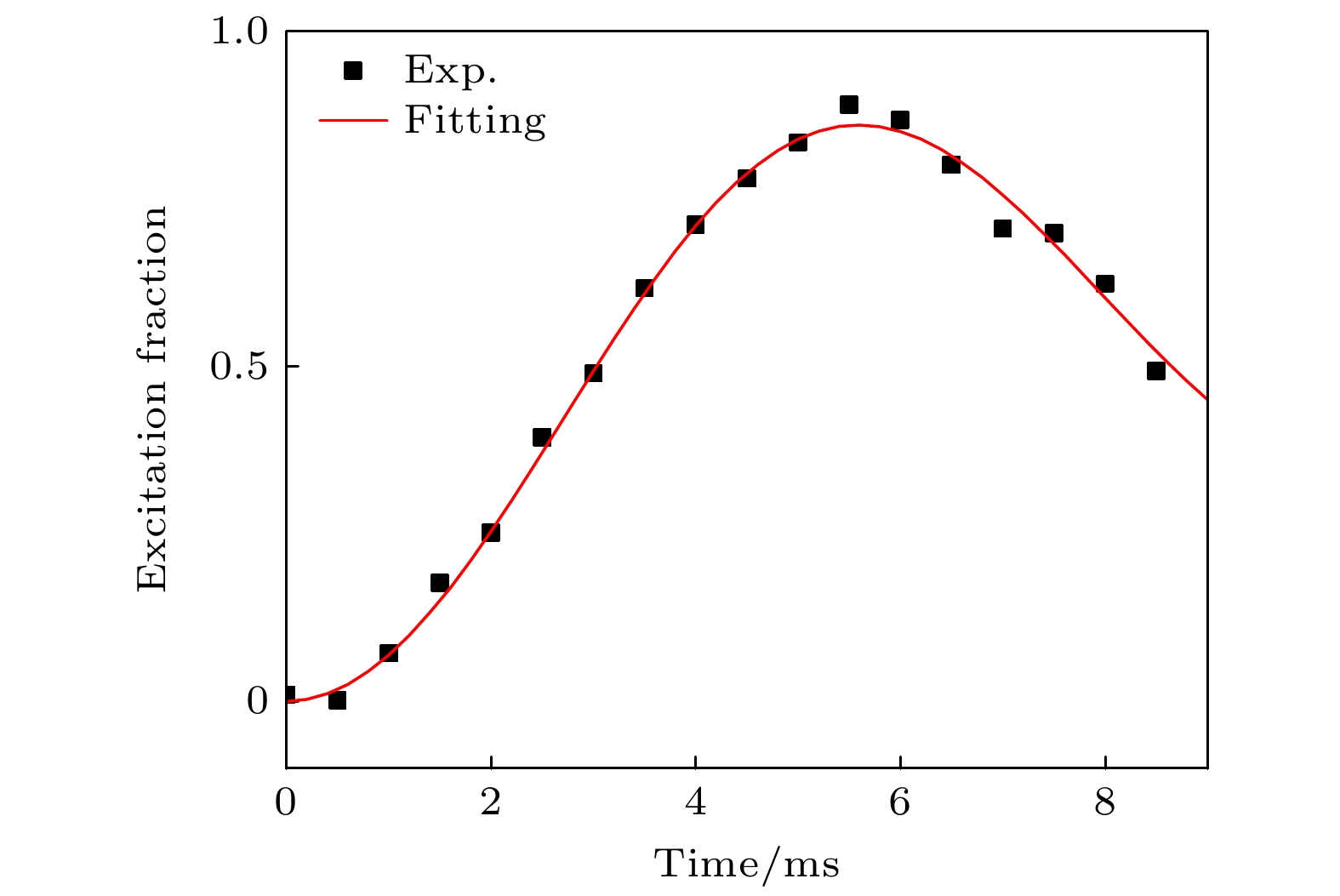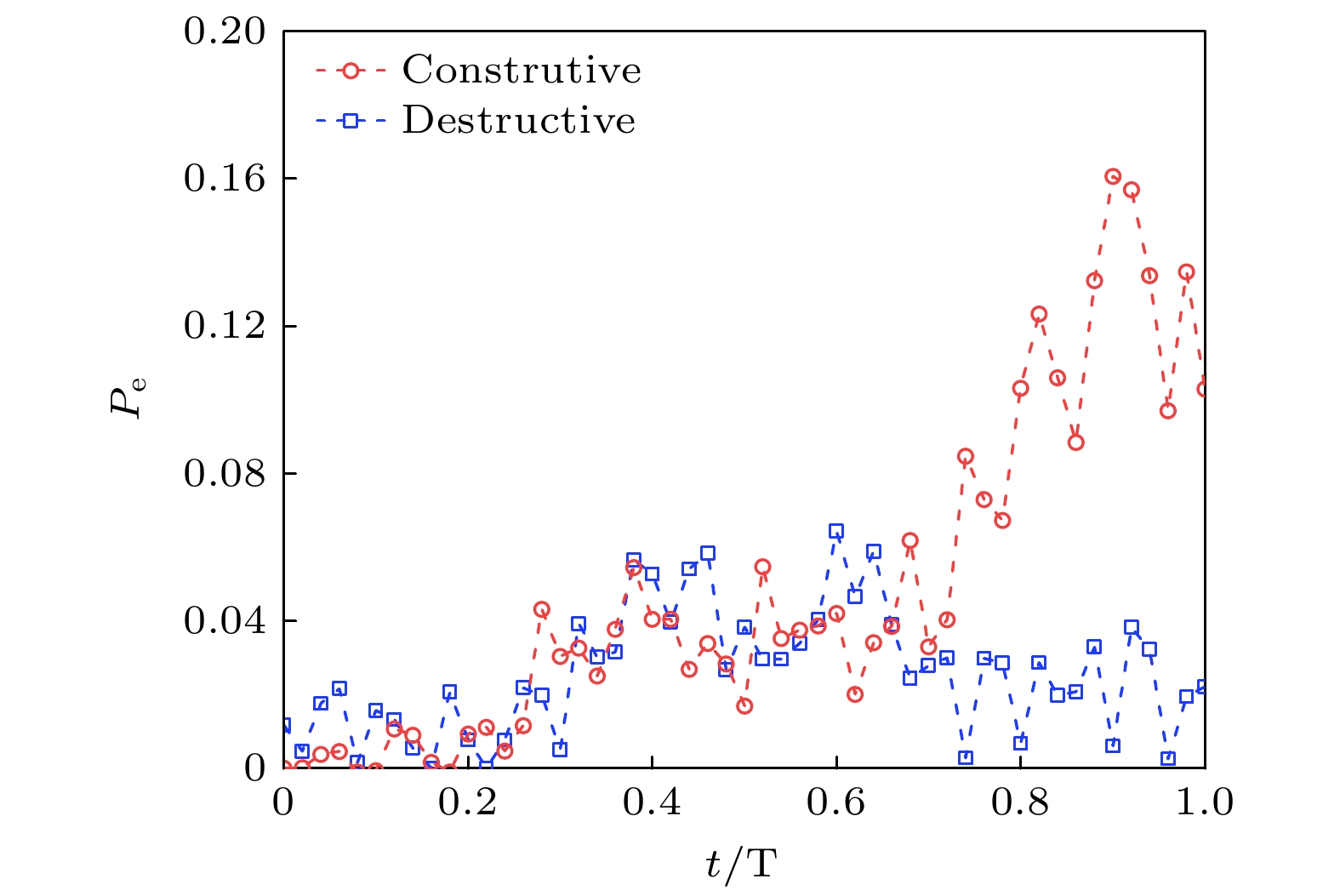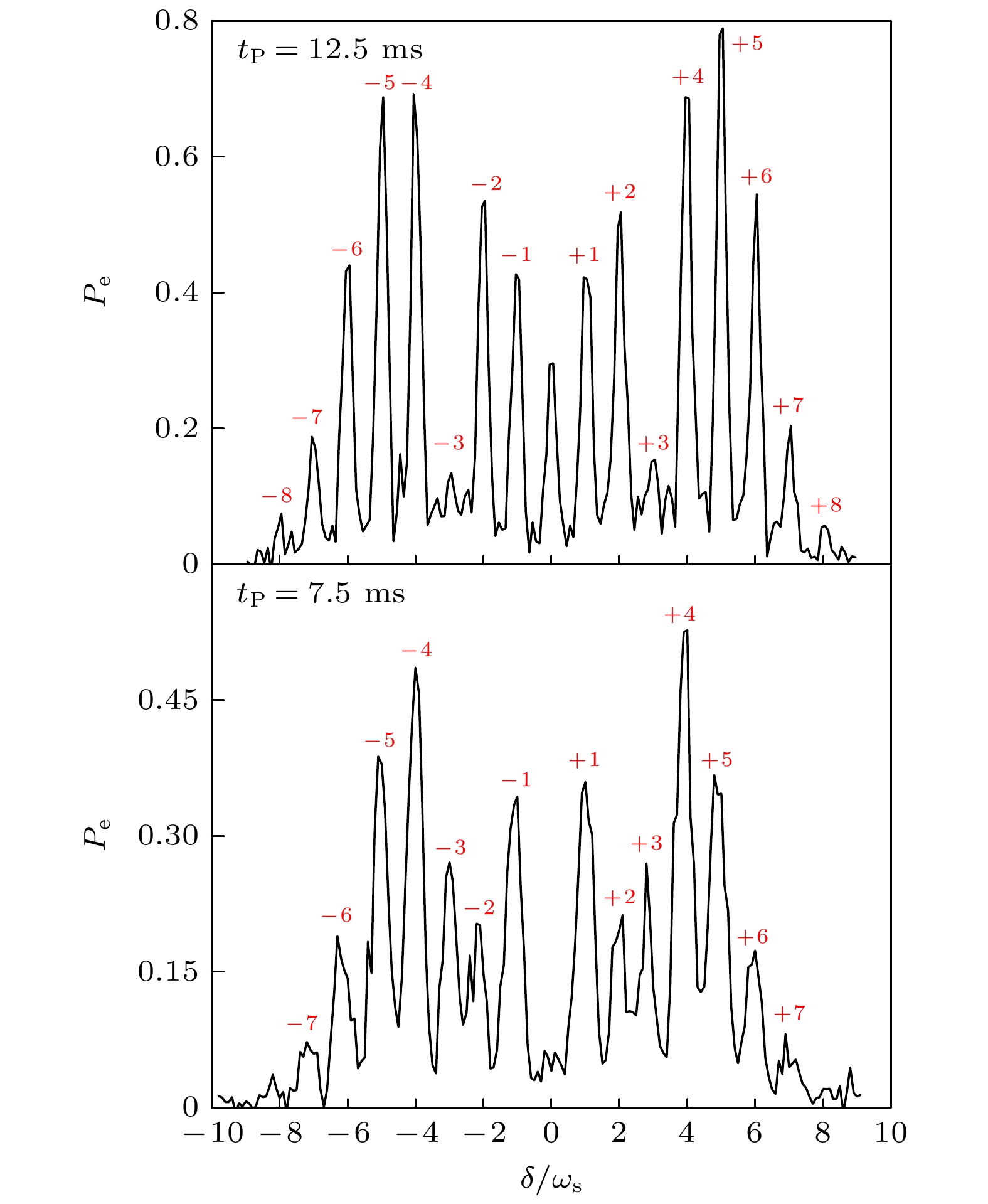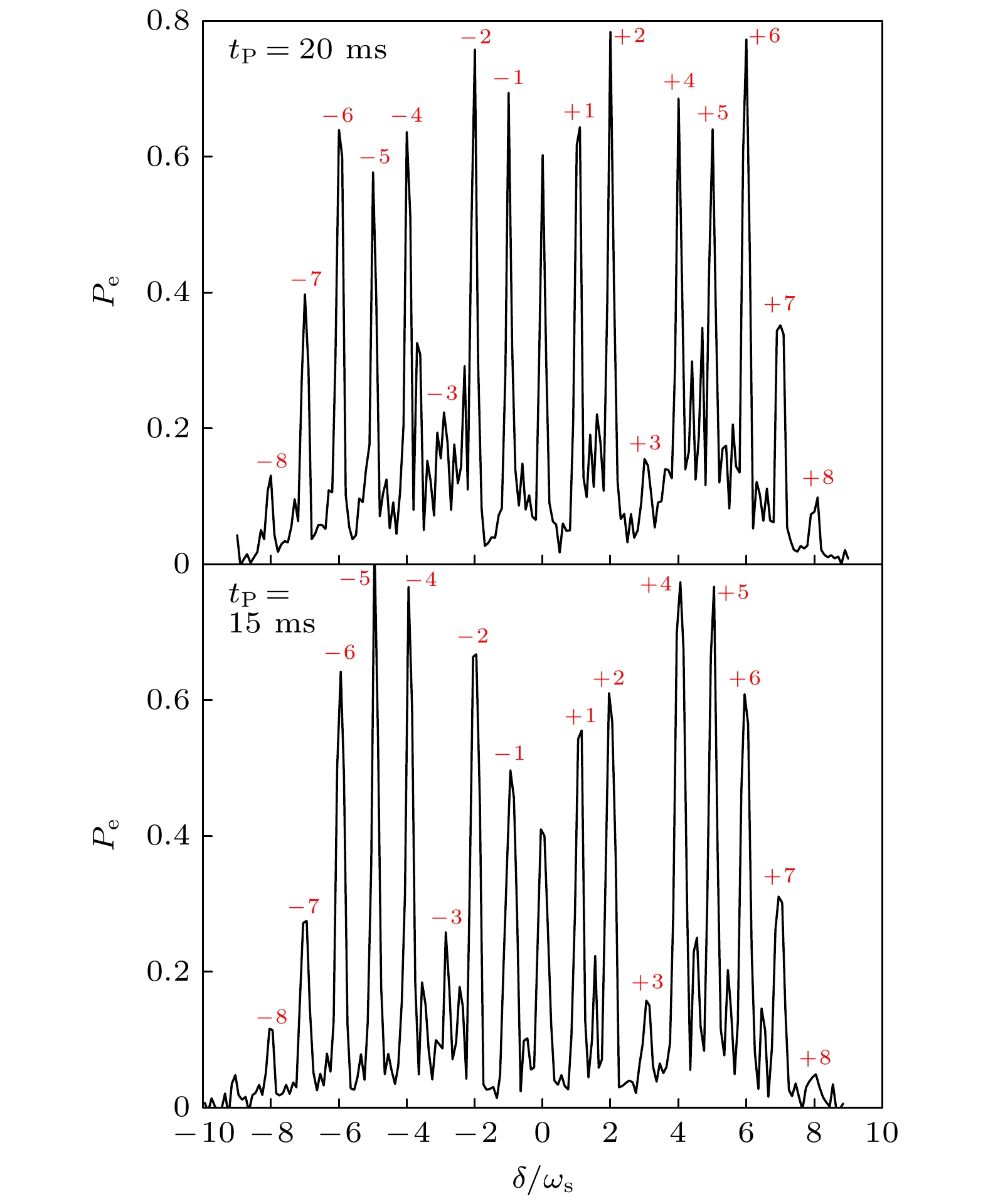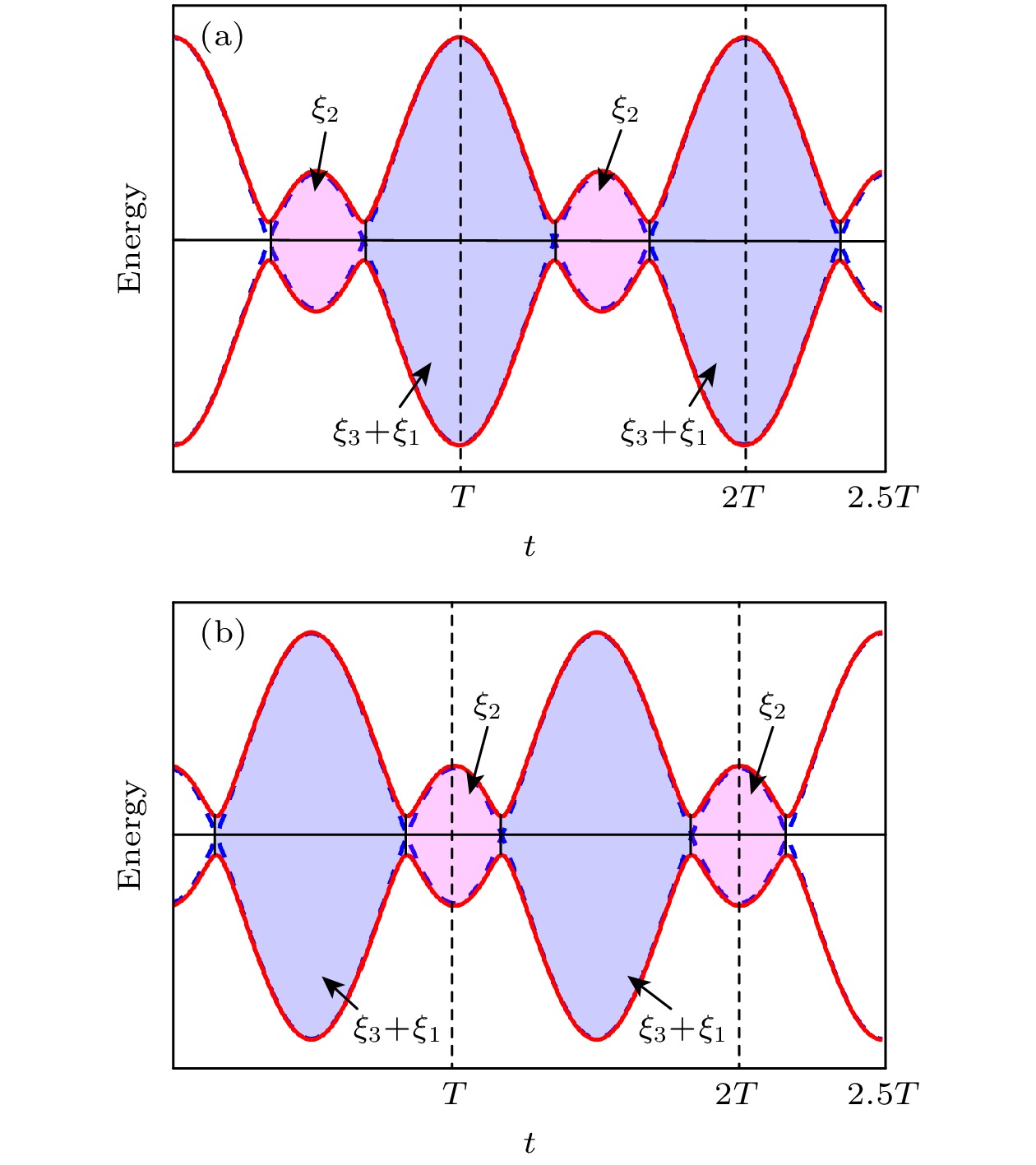-
时域Landau-Zener-Stückelberg-Majorana干涉在量子态操控、延长量子态寿命和抑制系统退相干方面具有重要应用价值. 本文基于87Sr光晶格钟平台, 通过周期性调制698 nm钟激光频率并优化光钟系统参数, 在快通道极限下实现了Landau-Zener跃迁, 并测量了不同实验参数下的时域Landau-Zener-Stückelberg-Majorana干涉边带谱. 由于调制后的激光与原子相互作用在时域上展现出干涉现象, 因此, 通过改变激光失谐可以探测不同钟激光作用时间下的时域干涉边带谱. 实验结果表明, 当钟激光作用时间为调制周期的整数倍时, 扫描钟激光的频率失谐, 干涉边带谱关于零失谐频率呈非对称分布. 而当作用时间为调制周期的半整数倍时, 干涉边带谱则呈对称分布. 该现象源于钟跃迁量子态演化过程中积累的有效动力学相位. 时域Landau-Zener-Stückelberg-Majorana干涉谱的研究为未来基于光晶格钟平台的态制备和研究噪声对Landau-Zener跃迁的影响奠定了实验基础.
Landau-Zener-Stückelberg-Majorana (LZSM) interference has significant application value in quantum state manipulation, extending quantum state lifetime, and suppressing decoherence. Optical lattice clock, with a long coherence time, increases the likelihood of experimentally observing time-domain LZSM interference. Although time-dominant Landau-Zener (LZ) Rabi oscillations have already been observed in optical lattice clock, the time-dominant LZSM interference sidebands in optical lattice clock remain unexplored. This study is based on an 87Sr optical lattice clock. By periodically modulating the frequency of the 698-nm clock laser and optimizing the parameters of the optical clock system, LZ transitions are achieved under the fast-passage limit (FPL). During the clock detection, two acoustic optical modulators (AOMs) are employed: AOM1 that compensates for the frequency drift of the clock laser and operates continuously throughout the experiment, and AOM2 that performs traditional clock transition detection and generates a cosine modulation signal by using an external trigger from the RF signal generator in Burst mode. Ultimately, the periodically modulated 698-nm clock laser with a frequency of $\omega (t) = \cos \left[ {\displaystyle\int {\left( {{\omega _{\text{p}}} - A{\omega _{\text{s}}}\cos {\omega _{\text{s}}}t} \right){\mathrm{d}}t} } \right]$ is used to probe atoms, and the Hamiltonian is $ {\hat H_n}(t) = \dfrac{h}{2}[\delta + A{\omega _{\text{s}}}\cos ({\omega _{\text{s}}}t)]{\hat \sigma _z} + \dfrac{{h{g_n}}}{2}{\hat \sigma _x} $. As the modulated laser interacts with the atoms, the interference phenomenon is exhibited in the time domain; adjusting the clock laser detuning allows for probing the time-domain LZSM interference sideband spectra at different detection times. The results show that the time-domain LZSM interference sideband consists of multiple sidebands. Specifically, ±kth order sidebands can be observed at δ/ωs = k, where k is an integer, representing constructive interference. Additionally, due to the different LZ Rabi oscillation periods for each sideband, the excitation fractions of different sidebands are also different, resulting in different excitation fractions for sidebands at the same clock detection time. When scanning the frequency of the clock laser, small interference peaks will appear next to the +1st, +4th, +5th, +6th, –3th and –4th order sidebands when detection time is an integer period. These peaks all appear on the right side of the sidebands, thus breaking the symmetry of LZSM interference sidebands. In contrast, when the detection time is a half-integer period, the interference sidebands exhibit symmetric distribution. This phenomenon mainly arises from the effective dynamical phase accumulated during the LZSM interference evolution. Moreover, the excitation fraction is higher than that at half-integer period, which holds potential application value in state preparation research. The experimental results are in excellent agreement with theoretical simulations, confirming the feasibility of conducting time-domain LZSM interference studies on the optical lattice clock. In the future, by further suppressing clock laser noise, the optical lattice clock will provide an ideal experimental platform for studying the effects of noise on LZ transition. -
Keywords:
- Landau-Zener transition /
- time-dominant Landau-Zener-Stückelberg-Majorana interference /
- optical lattice clock
[1] Landau L D 1932 Phys. Z. Sowjetunion 2 46
[2] Zener C 1932 Proc. R. Soc. London, Ser. A 137 696
 Google Scholar
Google Scholar
[3] Stückelberg E C G 1932 Helv. Phys. Acta 5 369
[4] Majorana E 1932 Nuovo Cimento 9 43
 Google Scholar
Google Scholar
[5] Xu K B, Xie T Y, Shi F Z, Wang Z Y, Xu X K, Wang P F, Wang Y, Plenio M B, Du J F 2019 Sci. Adv. 5 eaax3800
 Google Scholar
Google Scholar
[6] Fuchs G D, Burkard G, Klimov P V, Awschalom D D 2011 Nat. Phys. 7 789
 Google Scholar
Google Scholar
[7] Thalhammer G, Winkler K, Lang F, Schmid S, Grimm R, Denschlag J H 2006 Phys. Rev. Lett. 96 050402
 Google Scholar
Google Scholar
[8] Zenesini A, Lignier H, Tayebirad G, Radogostowicz J, Ciampini D, Mannella R, Wimberger S, Morsch O, Arimondo E 2009 Phys. Rev. Lett. 103 090403
 Google Scholar
Google Scholar
[9] Tayebirad G, Zenesini A, Ciampini D, Mannella R, Morsch O, Arimondo E, Lörch N, Wimberger S 2010 Phys. Rev. A 82 013633
 Google Scholar
Google Scholar
[10] Uehlinger T, Greif D, Jotzu G, Tarruell L, Esslinger T, Wang L, Troyer M 2013 Eur. Phys. J. Spec. Top. 217 121
 Google Scholar
Google Scholar
[11] Teranishi Y, Nakamura H 1998 Phys. Rev. Lett. 81 2032
 Google Scholar
Google Scholar
[12] Saito K, Kayanuma Y 2004 Phys. Rev. B 70 201304(R
 Google Scholar
Google Scholar
[13] Gaudreau L, Granger G, Kam A, Aers G C, Studenikin S A, Zawadzki P, Pioro-Ladrière M, Wasilewski Z R, Sachrajda A S 2012 Nat. Phys. 8 54
 Google Scholar
Google Scholar
[14] Cao G, Li H O, Tu T, Wang L, Zhou C, Xiao M, Guo G C, Jiang H W, Guo G P 2013 Nat. Commun. 4 1401
 Google Scholar
Google Scholar
[15] Gaitan F 2003 Phys. Rev. A 68 052314
 Google Scholar
Google Scholar
[16] Tan W, Liu W X, Chen Y X, Zhou C H, Zhao G D, Chang H, Wang T 2025 Phys. Rev. A 111 033102
 Google Scholar
Google Scholar
[17] Liu W X, Wang T, Zhang X F, Li W D 2021 Phys. Rev. A 104 053318
 Google Scholar
Google Scholar
[18] Shevchenko S N, Ashhab S, Nori F 2010 Phys. Rep. 492 1
 Google Scholar
Google Scholar
[19] Sen A, Sen D, Sengupta K 2021 J. Phys. Condens. Matter 33 443003
 Google Scholar
Google Scholar
[20] Liu H Y, Dai M C, Wei L F 2019 Phys. Rev. A. 99 013820
 Google Scholar
Google Scholar
[21] Zhou J W, Huang P, Zhang Q, Wang Z X, Tan T, Xu X K, Shi F Z, Rong X, Ashhab S, Du J F 2014 Phys. Rev. Lett. 112 010503
 Google Scholar
Google Scholar
[22] Aeppli A, Kim K, Warfield W, Safronova M S, Ye J 2024 Phys. Rev. Lett. 133 023401
 Google Scholar
Google Scholar
[23] Boyd M M, Zelevinsky T, Ludlow A D, Foreman S M, Blatt S, Ido T, Ye J 2006 Science 314 1430
 Google Scholar
Google Scholar
[24] Bloom B, Nicholson T L, Williams J, Campbell S, Bishof M, Zhang X, Zhang W, Bromley S L, Ye J 2014 Nature 506 71
 Google Scholar
Google Scholar
[25] Guo F, Tan W, Zhou C H, Xia J, Chen Y X, Liang T, Liu Q, Liu Y, He D J, Zhou Y Z, Wang W H, Shen Y, Zou H X, Chang H 2021 AIP Adv. 11 125116
 Google Scholar
Google Scholar
[26] Yin M J, Wang T, Lu X T, Li T, Wang Y B, Zhang X F, Li W D, Smerzi A, Chang H 2021 Chin. Phys. Lett. 38 073201
 Google Scholar
Google Scholar
[27] Blatt S, Thosen J W, Campbell G K, Ludlow A D, Swallows M D, Martin M J, Boyd M M, Ye J 2009 Phys. Rev. A 80 052703
 Google Scholar
Google Scholar
-
图 1 实验原理图 (a), (b)分别为LZSM干涉实验装置图和时序图; (c)二能级系统免交叉点附近的LZ跃迁示意图. 实线代表绝热表象下的能级E±, 虚线表示非绝热表象下的能级$|g \rangle $和$|e \rangle $
Fig. 1. Experimental diagram: (a), (b) The experimental setup and timing sequences of LZSM interference, respectively; (c) schematic diagram of LZ transition at the avoided crossing point of two-level system. The solid lines represent the adiabatic levels E±, and the dashed lines represent the diabatic levels $|g \rangle $ and $|e \rangle $.
图 3 FPL条件下一个调制周期的LZSM干涉谱线. 其中红色带圆形标记的虚线为A = 6.25时的相长干涉谱线, 蓝色带正方形标记的虚线为A = 5.15时的相消干涉谱线
Fig. 3. LZSM interference in FPL at one period. The red dashed line with circle markers represents constructive interference at A = 6.25, and the blue dashed line with square markers represents destructive interference at A = 5.15.
图 6 钟跃迁能级随钟激光作用时间变化的示意图 (a), (b)分别代表钟激光频率失谐为δ和–δ时的有效动力学相位累积. 其中红色实线为绝热能级, 蓝色虚线为非绝热能级, 填充区域为绝热演化过程积累的有效动力学相位
Fig. 6. Time evolution of energy levels of clock transition with (a) δ and (b) –δ. The red solid lines and the blue dashed lines represent the adiabatic levels and the diabatic levels, respectively. The shade areas represent collected effective dynamic phases during the adiabatic evolution.
-
[1] Landau L D 1932 Phys. Z. Sowjetunion 2 46
[2] Zener C 1932 Proc. R. Soc. London, Ser. A 137 696
 Google Scholar
Google Scholar
[3] Stückelberg E C G 1932 Helv. Phys. Acta 5 369
[4] Majorana E 1932 Nuovo Cimento 9 43
 Google Scholar
Google Scholar
[5] Xu K B, Xie T Y, Shi F Z, Wang Z Y, Xu X K, Wang P F, Wang Y, Plenio M B, Du J F 2019 Sci. Adv. 5 eaax3800
 Google Scholar
Google Scholar
[6] Fuchs G D, Burkard G, Klimov P V, Awschalom D D 2011 Nat. Phys. 7 789
 Google Scholar
Google Scholar
[7] Thalhammer G, Winkler K, Lang F, Schmid S, Grimm R, Denschlag J H 2006 Phys. Rev. Lett. 96 050402
 Google Scholar
Google Scholar
[8] Zenesini A, Lignier H, Tayebirad G, Radogostowicz J, Ciampini D, Mannella R, Wimberger S, Morsch O, Arimondo E 2009 Phys. Rev. Lett. 103 090403
 Google Scholar
Google Scholar
[9] Tayebirad G, Zenesini A, Ciampini D, Mannella R, Morsch O, Arimondo E, Lörch N, Wimberger S 2010 Phys. Rev. A 82 013633
 Google Scholar
Google Scholar
[10] Uehlinger T, Greif D, Jotzu G, Tarruell L, Esslinger T, Wang L, Troyer M 2013 Eur. Phys. J. Spec. Top. 217 121
 Google Scholar
Google Scholar
[11] Teranishi Y, Nakamura H 1998 Phys. Rev. Lett. 81 2032
 Google Scholar
Google Scholar
[12] Saito K, Kayanuma Y 2004 Phys. Rev. B 70 201304(R
 Google Scholar
Google Scholar
[13] Gaudreau L, Granger G, Kam A, Aers G C, Studenikin S A, Zawadzki P, Pioro-Ladrière M, Wasilewski Z R, Sachrajda A S 2012 Nat. Phys. 8 54
 Google Scholar
Google Scholar
[14] Cao G, Li H O, Tu T, Wang L, Zhou C, Xiao M, Guo G C, Jiang H W, Guo G P 2013 Nat. Commun. 4 1401
 Google Scholar
Google Scholar
[15] Gaitan F 2003 Phys. Rev. A 68 052314
 Google Scholar
Google Scholar
[16] Tan W, Liu W X, Chen Y X, Zhou C H, Zhao G D, Chang H, Wang T 2025 Phys. Rev. A 111 033102
 Google Scholar
Google Scholar
[17] Liu W X, Wang T, Zhang X F, Li W D 2021 Phys. Rev. A 104 053318
 Google Scholar
Google Scholar
[18] Shevchenko S N, Ashhab S, Nori F 2010 Phys. Rep. 492 1
 Google Scholar
Google Scholar
[19] Sen A, Sen D, Sengupta K 2021 J. Phys. Condens. Matter 33 443003
 Google Scholar
Google Scholar
[20] Liu H Y, Dai M C, Wei L F 2019 Phys. Rev. A. 99 013820
 Google Scholar
Google Scholar
[21] Zhou J W, Huang P, Zhang Q, Wang Z X, Tan T, Xu X K, Shi F Z, Rong X, Ashhab S, Du J F 2014 Phys. Rev. Lett. 112 010503
 Google Scholar
Google Scholar
[22] Aeppli A, Kim K, Warfield W, Safronova M S, Ye J 2024 Phys. Rev. Lett. 133 023401
 Google Scholar
Google Scholar
[23] Boyd M M, Zelevinsky T, Ludlow A D, Foreman S M, Blatt S, Ido T, Ye J 2006 Science 314 1430
 Google Scholar
Google Scholar
[24] Bloom B, Nicholson T L, Williams J, Campbell S, Bishof M, Zhang X, Zhang W, Bromley S L, Ye J 2014 Nature 506 71
 Google Scholar
Google Scholar
[25] Guo F, Tan W, Zhou C H, Xia J, Chen Y X, Liang T, Liu Q, Liu Y, He D J, Zhou Y Z, Wang W H, Shen Y, Zou H X, Chang H 2021 AIP Adv. 11 125116
 Google Scholar
Google Scholar
[26] Yin M J, Wang T, Lu X T, Li T, Wang Y B, Zhang X F, Li W D, Smerzi A, Chang H 2021 Chin. Phys. Lett. 38 073201
 Google Scholar
Google Scholar
[27] Blatt S, Thosen J W, Campbell G K, Ludlow A D, Swallows M D, Martin M J, Boyd M M, Ye J 2009 Phys. Rev. A 80 052703
 Google Scholar
Google Scholar
计量
- 文章访问数: 2864
- PDF下载量: 66
- 被引次数: 0













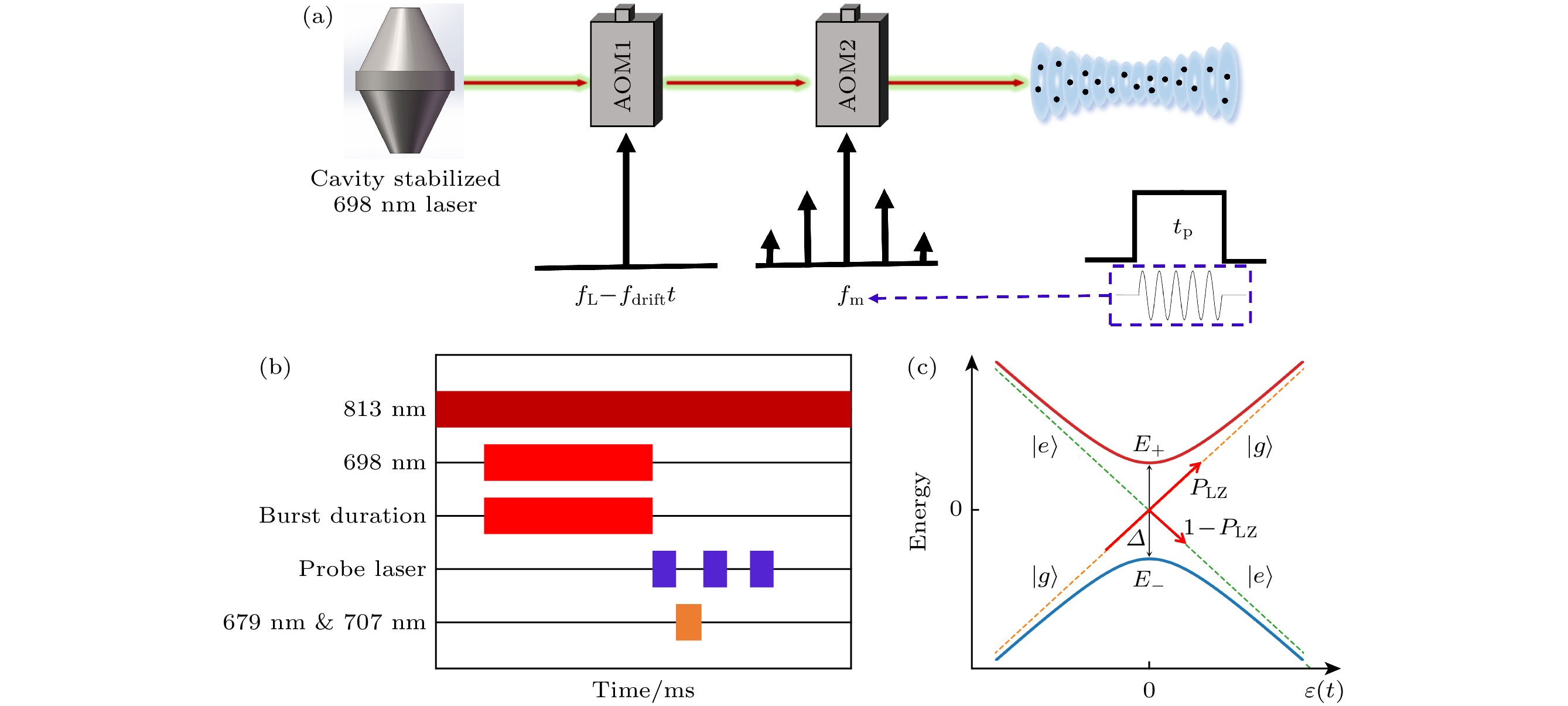
 下载:
下载:
